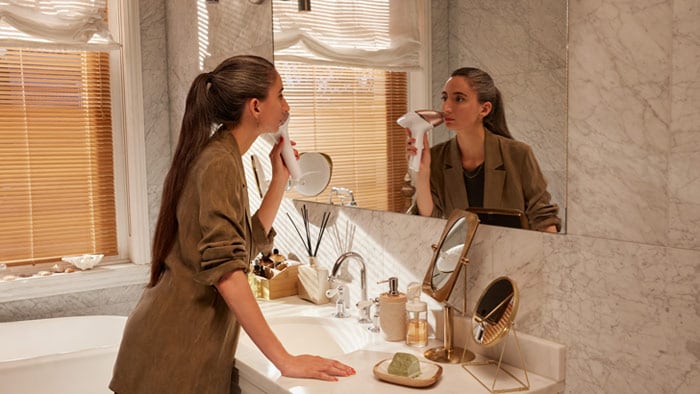
Best Ways to Remove Facial Hair

Unwanted hair growth on the chin is a common issue among women, which can cause discomfort and annoyance. Learning the proper techniques for how to remove chin hair can boost your self-esteem and confidence, and that’s where we come in. In this article, we will explore everything you need to know about chin hair removal, including: So, let’s get started. Read on to explore our simple guide to chin hair, and how you can make facial hair removal at home a quick, easy, and painless task.
Before we dive into our simple guide for how to remove chin hair, it’s important to understand the different types of hair. Below you can discover the definition of the two main types of hair1 before moving on to read our guide to get rid of chin hair.
Many women are unaware of how common chin hair and other facial hair are, but that doesn't make discovering it any more enjoyable. There are several reasons why women develop and subsequently start methods of facial hair removal at home, including:
If you want to remove chin hair, it’s important to make sure that you prepare your skin before starting any hair removal method. Here are our four simple steps to prepare your skin for facial hair removal at home:
If you’re looking for tips on how to get rid of chin hair, you have landed on the right page. Now you understand the reasons behind the growth of unwanted hair and how to get your skin ready for hair removal, here are our five effective techniques to remove chin hair.
Probably most of us have experienced that moment when we find long, dark, wavy hairs in an unexpected spot and have to use tweezers to remove them. Plucking each unwanted hair out with tweezers is the best chin hair removal method if you only have a few to remove.
Top tip: For minimal pain and reduced risk of infection, we recommend tweezing immediately after taking a shower. The hot water helps to remove excess oils and build-up in your pores and hair follicles, making it easier to pluck those unwanted hairs right from the base.
If you have tried waxing to get rid of chin hair, you may have experienced irritated and painful skin afterwards. Unlike waxing, sugaring removes unwanted hair in the direction of growth, causing less irritation which can therefore also be suitable for more sensitive skin. However, this method may take a little longer as you may need to repeat the process to remove all the excess hair growth. And you should maybe test this method on a less sensitive and visible area first if it’s your first time trying it out.
Threading is a hair removal method that many people find less painful and more suitable for sensitive skin. This technique doesn't involve the use of any chemicals or products that may cause skin irritation. If you have sensitive skin or simply don't like traditional hair removal methods, threading could be the perfect chin hair removal solution for you.
Top tip: If you choose to go the threading route, it's important to work with an experienced aesthetician who uses cotton suitable for sensitive skin to ensure the best outcome.
Intense pulsed light therapy (IPL) can get rid of chin hair with more long-lasting results. This method targets melanin in the hair and works best if you have light skin and dark hair. IPL offers longer-lasting results than traditional methods but is still not fully permanent.
Top tip: The Philips Lumea IPL 9000 Series is a great choice for facial hair removal at home, offering pain-free, easy, long-lasting hair removal. Don’t just take our word for it. Get your questions answered by real women in these IPL hair removal reviews.
For women who are okay with some facial hair but would like it to be less noticeable, there are over-the-counter bleaching products that may help. However, it's important to conduct a patch test before using these products to avoid any adverse reactions, especially if you're using them on the sensitive skin of your face.
Whilst chin hair growth is extremely common for women, there are times when it could be a symptom of something you need to get checked out. You should speak to your doctor for advice if you notice any of the following in addition to needing to remove chin hair:2 So, there you go. In this article, we have provided you with a simple guide to help you learn how to get rid of chin hair using easy at-home methods. Our guide includes everything you need to know about the five best chin hair removal techniques, along with advice on how to care for and protect your skin. By following these steps, you will be able to get rid of chin hair quickly and effectively.